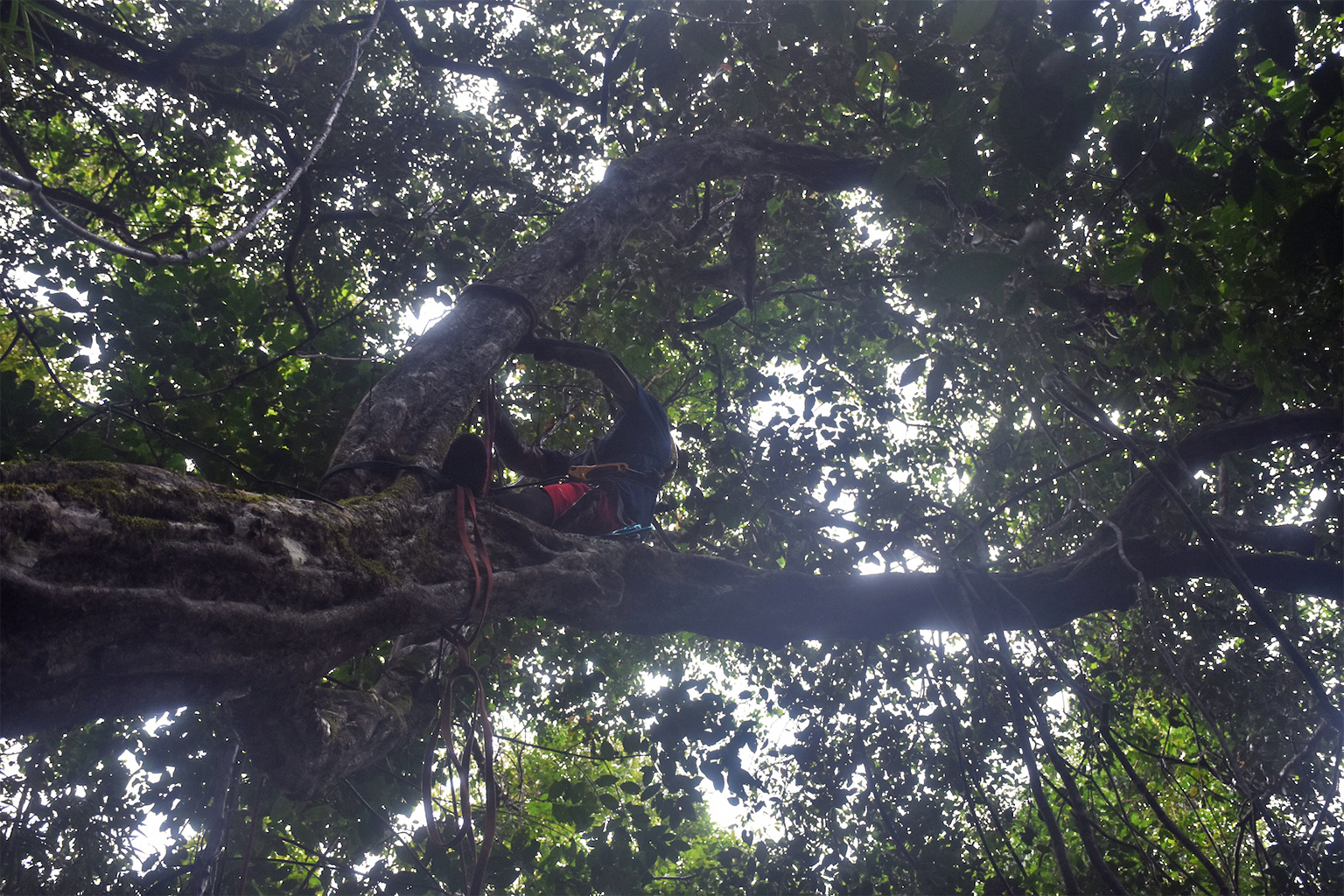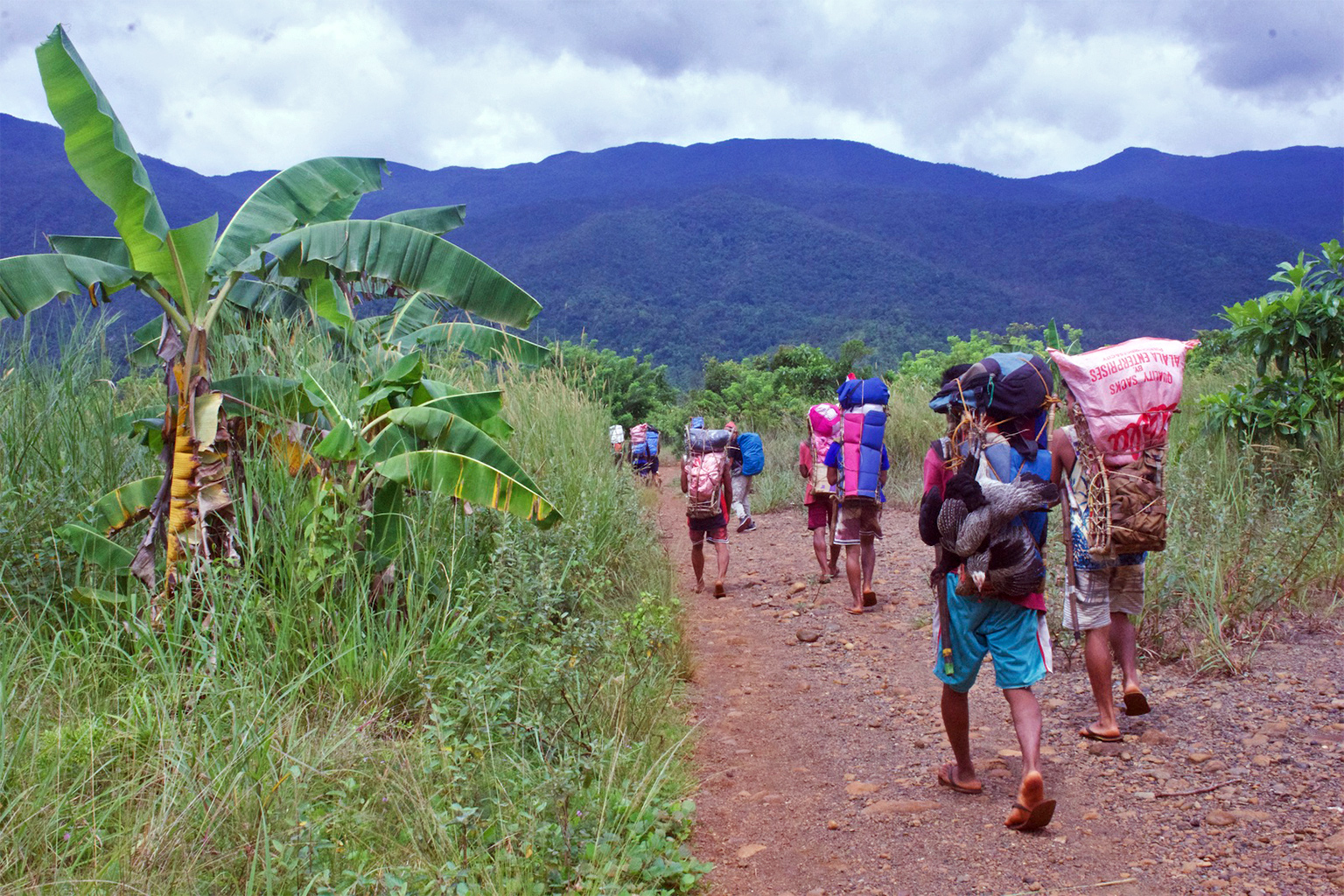- Scientists have identified 228 key biodiversity areas in the Philippines, but only 91 are currently part of the country’s network of protected areas.
- Conservationists see an opportunity in the adoption of the new Global Biodiversity Framework, which commits signatories like the Philippines to protecting 30% of terrestrial and marine ecosystems by 2030.
- However, experts caution that protecting biodiversity is not as simple as creating new protected areas on paper, and that care needs to be taken to protect the rights and interests of Indigenous and local communities.
After hours of wading through raging rivers and braving the steep, slippery slopes of the Victoria-Anepahan Mountain Range (VAMR) on a rainy morning in October 2022, wildlife specialist Aubrey Jayne Padilla and her Indigenous Tagbanua parabiologist companions breathed sighs of relief as they reached Atabay Lake, one of their three research stations and base camp for the next five days.
“The lake is very magical,” Padilla, a National Geographic explorer and research project coordinator of the environmental organization Centre for Sustainability (CS), told Mongabay in a video interview. “It’s tucked away in an enchanting forest where a wide range of wildlife abounds.”
Straddling the central-southern part of the Philippines’ Palawan province, the 164,789-hectare (407,202-acre) mountain range is a Key Biodiversity Area, defined by global wildlife conservation authority the IUCN as greatly contributing to the planet’s biodiversity and overall health.
While setting up wildlife camera traps, Padilla says she gained a deeper appreciation of how Indigenous stewardship and prohibitions on extractive industries have been vital in conserving Victoria-Anepahan, particularly Kensad mountain. The 8,063-hectare (19,924-acre) Kensad is part of the Tagbanua’s ancestral domain and home to an array of Philippine endemic species, including pangolins and cockatoos.

Yet, despite the local government’s promise to conserve the area, VAMR remains poorly protected from illegal logging, swidden farming and mining. This mountain range is emblematic of what the Philippines has overlooked for years: 137 of the country’s 228 identified Key Biodiversity Areas don’t fall within the national network of protected areas, known as NIPAS, despite advocacy efforts by conservationists and Indigenous peoples.
As of 2022, this megadiverse archipelago has 248 protected areas, including seven newly legislated ones, covering 7.8 million hectares (3.2 million acres), or about 15.4% of the country’s land area and 1.4% of its territorial waters.
With the adoption of the new Global Biodiversity Framework (GBF) at the December 2022 U.N. Biodiversity Conference, which commits signatories to protecting 30% of terrestrial and marine ecosystems by 2030, conservationists see a renewed opportunity to push for the expansion of the Philippines’ protected area system. However, experts also caution that truly protecting critical ecosystems isn’t as simple as demarcating them on paper.

Safeguarding KBAs
A signatory to the Convention on Biological Diversity, the Philippine government renewed its commitment to expand its protected area coverage following the identification of more potential areas, including KBAs. “We must now look beyond restoration, and together work towards investing in the regeneration of life on land and below water to achieve a nature-positive world,” Environment and Natural Resources Secretary Maria Antonio Yulo-Loyzaga said in a statement.
There’s much to celebrate in the announcement, experts say.
More protected areas mean more venues for research and more opportunities for conservation funding, says Rogelio Andrada II, a protected area management professor at the University of the Philippines Los Baños, in an instant message to Mongabay.
Scientists say they hope the government’s pronouncement translates into affording the highest legal protection status to the VAMR and other unprotected key biodiversity hotspots, which collectively serve as habitats for 855 globally important terrestrial and marine species.
“Science was not driving the selection of protected areas; [their] selection was mostly political,” says Neil Aldrin Mallari, lead author of a recent study that found the current protected areas network doesn’t fully cover suitable habitats of threatened and endemic species.
“If we protect all of these [terrestrial KBAs], we can surely hit more than 30% of our total land area,” adds Mallari, who is also president of the nonprofit Center for Conservation Innovations and regional focal point of the IUCN World Commission on Protected Areas.
Because setting up protected areas is a nature-based solution that helps maintain ecosystem integrity and reduce climate extreme impacts, “this initiative … can contribute to the climate resilience of the Philippines,” which is among the countries considered highly vulnerable to climate change, says Lourdes Tibig, climate science adviser at the nonprofit think tank Institute for Climate and Sustainable Cities.

Potential pitfalls
Despite generally favoring the expansion of protected areas, experts caution about the potential pitfalls.
“[There’s] danger that these PAs will not be managed well and will just be protected areas on paper because we currently don’t have enough human resources to manage existing PAs as it is,” Andrada says. “Management of new PAs can eat up a portion of the national budget that can be used for other purposes.”
In its country statement for the 2022 Biodiversity Conference, the Philippine government said public expenditure for biodiversity is increasing, but identified a funding gap of at least 14 billion pesos ($250 million) annually, “particularly for protection and restoration.”
“We expect this gap to remain deeply significant, if not larger than previously determined,” Yulo-Loyzaga said, calling for private sector investment interventions.
For traditional communities heavily reliant on natural resources for survival, expansion of national parks may not be well received. “In our haste to establish new PAs, there is a danger that it may not be done properly and not take into account other perspectives,” Andrada says, such as having “less land or water that are available for food production.”
These are among the concerns raised by Bukluran, a coalition of Indigenous peoples campaigning for government recognition and respect for their traditional governance over their ancestral domains and natural resources. The group is lobbying for the passage of the Indigenous Communities Conserved Territories and Areas (ICCAs) bill.
The proposed law upholds sustainable traditional resources rights and recognizes ICCAs as a protected area category under Indigenous ownership, control and governance. Since 2011, 16 Philippine ICCAs covering a combined 349,423 hectares (863,442 acres) have been registered with the U.N. Environment Programme’s World Conservation Monitoring Centre, which maps ICCAs worldwide.
In protecting the Philippines’ last remaining wild places within territories that are still occupied and stewarded by Indigenous peoples, one key challenge is reconciling NIPAS with the Indigenous Peoples Rights Act, ensuring that a rights-based approach is considered, said KM Reyes, co-founder of the Centre for Sustainability.
“So incorporated in these should definitely be traditional knowledge and practices,” Reyes tells Mongabay in an instant message. “[Indigenous communities] need to be a key stakeholder and hopefully their governance systems are not displaced by any kind of government management systems thereafter.”

Still not enough
Even the newly adopted Global Biodiversity Framework is “still inadequate” to reverse biodiversity decline, Tibig says. “Halting biodiversity loss will need more than just a 30×30 target,” she tells Mongabay in an email.
Besides expanding protected areas and other effective area-based conservation measures, governments must vigorously reduce or avoid carbon emissions to slow down climate change that has shifted species distribution, Tibig says. They should also tackle overexploitation and overconsumption, the compounding factors contributing to biodiversity collapse, she adds.
Mallari says that beyond broadening the NIPAS coverage, he hopes to see further improvements in the management effectiveness of existing protected areas. “All of the protected areas have improved [from poor to fair from 2013 to 2017 as per our study] but they’re below the passing score,” he says. “Can the government achieve [its new targets] given that these [protected areas] were not faring very well?”
The government needs to resolve key issues, including politics that dictate the inappropriate design of protected areas, and low capacity of staff to maximize the use of available cutting-edge conservation technologies, Mallari says, adding that doing so is possible and the urgency justifies it.
“The more we look at the vulnerability of biodiversity to the deleterious effects of climate change, or the many anthropogenic pressures, the more we see evidence that our vulnerability increases as species decline,” he says.
Banner image: A narcissus flycatcher (Ficedula narcissina) in the Philippines. Image by Hiyashi Haka via Flickr (CC BY-NC-SA 2.0).
Citation:
Ambal, R. G., Duya, M. V., Cruz, M. A., Coroza, O. G., Vergara, S. G., de Silva, N., … Tabaranza, B. (2012). Key biodiversity areas in the Philippines: Priorities for conservation. Journal of Threatened Taxa, 4(8), 2788-2796. doi:10.11609/JoTT.o2995.2788-96
Mallari, N. A., Edaño, J. W., Jasmin, C. J., Jaojoco, A. K., & Masigan, J. P. (2020). Multidimensional indicators to improve management effectiveness monitoring of protected areas. Philippine Journal of Systematic Biology, 14(2). doi:10.26757/pjsb2020b14019
Mallari, N. A., Collar, N. J., McGowan, P. J., & Marsden, S. J. (2015). Philippine protected areas are not meeting the biodiversity coverage and management effectiveness requirements of Aichi Target 11. Ambio, 45(3), 313-322. doi:10.1007/s13280-015-0740-y
FEEDBACK: Use this form to send a message to the author of this post. If you want to post a public comment, you can do that at the bottom of the page.
